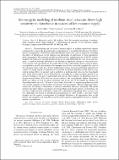Files in this item
Bio-energetic modeling of medium-sized cetaceans shows high sensitivity to disturbance in seasons of low resource supply
Item metadata
| dc.contributor.author | Hin, Vincent | |
| dc.contributor.author | Harwood, John | |
| dc.contributor.author | de Roos, André M. | |
| dc.date.accessioned | 2019-05-17T12:30:01Z | |
| dc.date.available | 2019-05-17T12:30:01Z | |
| dc.date.issued | 2019-07 | |
| dc.identifier | 258659176 | |
| dc.identifier | edf03b73-d2ac-444f-b741-a93a1afecee4 | |
| dc.identifier | 000474485400014 | |
| dc.identifier | 85068211317 | |
| dc.identifier.citation | Hin , V , Harwood , J & de Roos , A M 2019 , ' Bio-energetic modeling of medium-sized cetaceans shows high sensitivity to disturbance in seasons of low resource supply ' , Ecological Applications , vol. 29 , no. 5 , e01903 . https://doi.org/10.1002/eap.1903 | en |
| dc.identifier.issn | 1051-0761 | |
| dc.identifier.other | RIS: urn:6AC71B101B26F1C93154AB63F6570955 | |
| dc.identifier.uri | https://hdl.handle.net/10023/17717 | |
| dc.description | This research was supported by the Office of Naval Research grant N00014-16-1-2858: "PCoD+: Developing widely-applicable models of the population consequences of disturbance”. VH and AMdR benefitted from funding from the European Research Council under the European Union’s Seventh Framework rogramme (F /2007-2013) / ERC Grant Agreement No. 322814 awarded to AMdR. | en |
| dc.description.abstract | Understanding the full scope of human impact on wildlife populations requires a framework to assess the population‐level repercussions of nonlethal disturbance. The Population Consequences of Disturbance (PCoD) framework provides such an approach, by linking the effects of disturbance on the behavior and physiology of individuals to their population‐level consequences. Bio‐energetic models have been used as implementations of PCoD, as these integrate the behavioral and physiological state of an individual with the state of the environment, to mediate between disturbance and biological significant changes in vital rates (survival, growth, and reproduction). To assess which levels of disturbance lead to adverse effects on population growth rate requires a bio‐energetic model that covers the complete life cycle of the organism under study. In a density‐independent setting, the expected lifetime reproductive output of a single female can then be used to predict the level of disturbance that leads to population decline. Here, we present such a model for a medium‐sized cetacean, the long‐finned pilot whale (Globicephala melas). Disturbance is modeled as a yearly recurrent period of no resource feeding for the pilot whale female and her calf. Short periods of disturbance lead to the pre‐weaned death of the first one or more calves of the young female. Higher disturbance levels also affect survival of calves produced later in the life of the female, in addition to degrading female survival. The level of disturbance that leads to a negative population growth rate strongly depends on the available resources in the environment. This has important repercussion for the timing of disturbance if resource availability fluctuates seasonally. The model predicts that pilot whales can tolerate on average three times longer periods of disturbance in seasons of high resource availability, compared to disturbance happening when resources are low. Although our model is specifically parameterized for pilot whales, it provides useful insights into the general consequences of nonlethal disturbance. If appropriate data on life history and energetics are available, it can be used to provide management advice for specific species or populations. | |
| dc.format.extent | 19 | |
| dc.format.extent | 4446349 | |
| dc.language.iso | eng | |
| dc.relation.ispartof | Ecological Applications | en |
| dc.subject | Cetacean life history | en |
| dc.subject | Dynamic Energy Budget model | en |
| dc.subject | Globicephala melas | en |
| dc.subject | Lifetime reproductive output | en |
| dc.subject | Marine mammals | en |
| dc.subject | Population consequences of disturbance | en |
| dc.subject | Vital rates | en |
| dc.subject | QH301 Biology | en |
| dc.subject | DAS | en |
| dc.subject | SDG 14 - Life Below Water | en |
| dc.subject.lcc | QH301 | en |
| dc.title | Bio-energetic modeling of medium-sized cetaceans shows high sensitivity to disturbance in seasons of low resource supply | en |
| dc.type | Journal article | en |
| dc.contributor.institution | University of St Andrews. School of Biology | en |
| dc.contributor.institution | University of St Andrews. Scottish Oceans Institute | en |
| dc.contributor.institution | University of St Andrews. St Andrews Sustainability Institute | en |
| dc.contributor.institution | University of St Andrews. Centre for Research into Ecological & Environmental Modelling | en |
| dc.identifier.doi | https://doi.org/10.1002/eap.1903 | |
| dc.description.status | Peer reviewed | en |
This item appears in the following Collection(s)
Items in the St Andrews Research Repository are protected by copyright, with all rights reserved, unless otherwise indicated.

